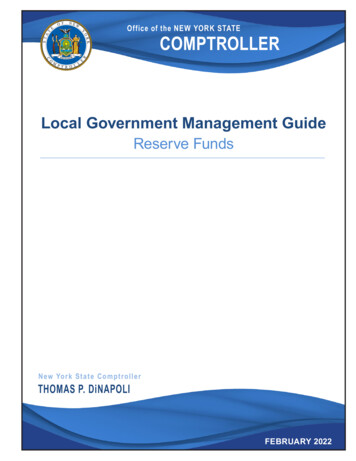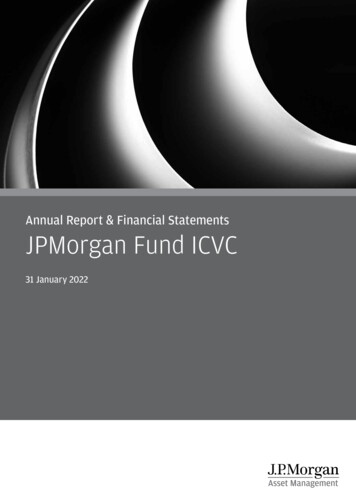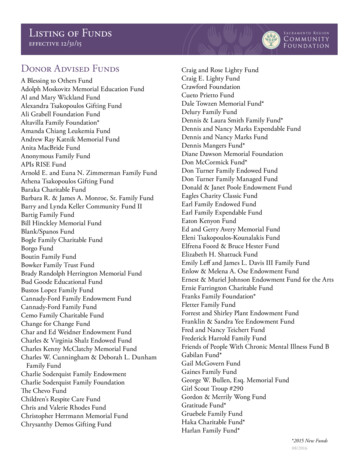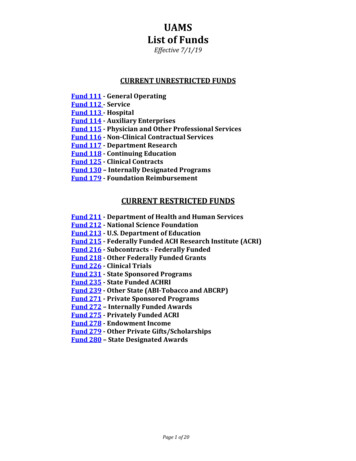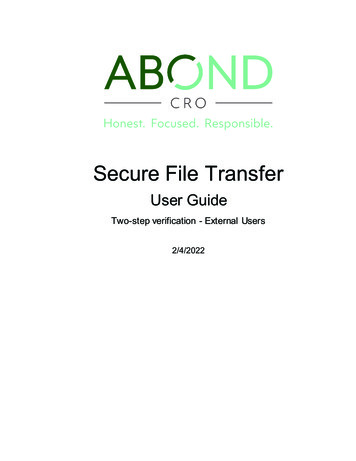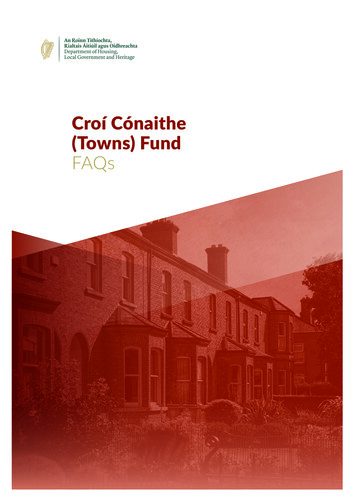
Transcription
Croí Cónaithe(Towns) FundFAQswww.housingagency.ie
Croí Cónaithe (Towns) Fund Vacant Property Refurbishment Grant FAQs1. What is Croí Cónaithe (Towns)?The Croí Cónaithe (Towns) Fund is a fund of 50 million to support people to live in towns and villagesin Ireland by providing a grant to refurbish vacant properties.2. Why is Croí Cónaithe (Towns) needed?Against the backdrop of policy commitments including the Programme for Government: Our SharedFuture, the National Planning Framework, Housing for All and Town Centre First, the Croí Cónaithe (Towns)Fund aims to tackle vacancy and dereliction in towns and villages around the country.The fund is being established to provide new choices for people to live in towns and villages inIreland. It aims to support the future growth and development of towns and villages by deliveringthe sustainable reuse of vacant properties as new homes which can also support wider regenerationoutcomes. In doing so, it provides the opportunity to strengthen Ireland’s rural urban fabric,support the communities who live there as well as reusing existing building, thus making a valuablecontribution to the Government’s Climate Action Plan 2021.3. What funding is available to applicants?A grant of up to a maximum of 30,000 will be available for the refurbishment of a vacant propertyfor occupation of the homeowner, including the conversion of a property which has not been used asresidential heretofore (subject to appropriate planning exemptions or permission being in place), as aprincipal private residence. This will be subject to upper limits for the types of work specified belowhaving regard to a reasonable cost assessment by the local authority. The grant is inclusive of VAT costof the works.Where the refurbishment costs are expected to exceed the standard grant of up to 30,000, amaximum top-up grant amount of up to 20,000 will be available where the property is confirmed bythe applicant to be derelict (i.e. structurally unsound and dangerous) or if the property is already onthe Derelict Sites Register bringing the total grant available for a derelict property up to a maximum of 50,000.In the case of a top-up grant in respect of a derelict property where the property is not on the DerelictSites Register, an independent report prepared by an appropriately qualified professional (e.g. quantitysurveyor, engineer etc.) is required to be submitted along with the application confirming that theproperty is derelict (i.e. structurally unsound and dangerous).Those applying for the grant will be required to indicate on the application form to confirm if they areapplying for the vacant property refurbishment grant alone or the vacant property refurbishment grantincluding the derelict property top-up grant.Properties considered for inclusion must be vacant for two years or more and built before 1993.For the purposes of this scheme, a property is deemed to be vacant if it has been vacant andunoccupied for a period of two years or more. Confirmation of vacancy can be validated and verifiedby the use of, for example, utility bills which can help determine vacancy periods (e.g. pattern ofusage or disconnection) or such other proofs as are available to the satisfaction of the local authority.Confirmation of vacancy must be validated and verified by the local authority prior to grant approval.1
Croí Cónaithe (Towns) Fund Vacant Property Refurbishment Grant FAQs4. Who will manage the Croí Cónaithe (Towns) Fund?The Fund will be managed and administered by local authorities on behalf of the Department ofHousing, Local Government and Heritage. Each local authority will receive and review applications forthe Vacant Property Refurbishment Grant.5. How will applications be assessed?Applications will be assessed by the relevant local authority based on:k framework of priorities as outlined below (see question 6)k proof of ownership or evidence of active negotiations to purchase the propertyk proof that the property is/has been vacant for 2 years or morek in the case where a top-up grant of up to 20,000 is being sought for a derelict property,confirmation that it is on the Derelict Sites Register or proof that the property is structurallyunsound and dangerous6. Who is eligible for Croí Cónaithe (Towns)?The Fund is focused on home ownership. There is a significant level of activation required of theparticipants through the refurbishment of a vacant property. A range of individuals or households willbe eligible to avail of the scheme, with the prioritisation of applications for consideration using theframework below and in line with overall funding available. The priorities will be implemented on asliding scale.Framework of Priorities123Applicants who are first time buyers (i.e. not have purchased or built a home for themselves)or who qualify under the ‘Fresh Start’ principle. The Fresh Start principle includes previoushomeowners who have experienced divorce or separation, or insolvency or bankruptcy, andwho no longer have a legal interest in the previous home.Applicants (other than 1 above) who have particular needs – specifically, disabled people orolder people who are moving from their current home which they are selling or have sold andwant to live in a town or village setting.Applicants (other than 1 and 2 above) who are moving from their current home which theyare selling or have sold and want to live in a town or village setting.2
Croí Cónaithe (Towns) Fund Vacant Property Refurbishment Grant FAQs7. What types of refurbishment work are covered under theCroí Cónaithe (Towns) Fund?The following categories of works will be eligible for grant assistance, subject to a reasonable costassessment by the local authority and to any limits for specific works as may be set out in guidancefrom the Department of Housing, Local Government and Heritage:k substructure works, including works to foundations, rising walls, floor slabs, damp-proofing andunderpinningk structural works to superstructure, including walls, party walls, chimneys, suspended timber floors,structural timbersk works to internal walls, stairs, and landings, and internal wall completions including doors, windows,and applied finishesk external walls completions including doors, windows, sills, and applied finishesk roof completions, including flashings, fascias, soffits, gutters, downpipesk building services including plumbing, heating, ventilation, electrical services, telecommunications,k painting and decoration required because of works carried outk extension within the ambit of exempt development under planning regulations, as part of a widerrefurbishmentk necessary external works and site development works carried out within the curtilage of the sitek professional services associated with works8. When will the grant be paid?When the refurbishment work has been completed for habitation by the homeowners, your localauthority will inspect the property. Once the local authority is satisfied that the works have beencompleted in line with the approved application, the grant will then be paid.9. Where should the property be located in relation to atown?There are over 500 towns and villages in Ireland with a population of over 400 people. It is intendedthat the Croí Cónaithe Fund will apply in all such towns and villages, and also to some smaller villages,which may not be defined for the purposes of the Central Statistics Office (CSO) Census mapping butwith sufficient provision of services and amenities.Qualifying properties should be:- Within a town or village boundary as defined- Walkable to town/village centre along public footpaths primarily3
Croí Cónaithe (Towns) Fund Vacant Property Refurbishment Grant FAQs10. What is a town for the purposes of the scheme?While initially the Fund will not apply to towns within the city and suburb boundaries of Dublin, Cork,Limerick, Galway and Waterford, as defined by the CSO Census mapping, the potential for inclusionof such towns within cities and suburbs will be further considered during the initial phase of theprogramme.Towns outside of the city and suburb boundary in the CSO Census mapping are defined as a separate‘town’ and will therefore be eligible, e.g. Balbriggan.11. Do I have to own a property in order to avail of thisgrant?Yes. Proof of both vacancy and ownership will be required to support the grant payment. In terms ofownership, it is a matter for the applicant to confirm ownership with the local authority.A local authority may give approval in principle to a grant application where the applicant is ableto provide evidence of active negotiations to purchase a property i.e. confirmation of engagementfrom the estate agency or owner of the property and where the owner provides such evidence as tovacancy as is required under the scheme on behalf of the applicant. Such approval in principle shallnot be confirmed as approval in full until ownership has transferred to the applicant and no drawdownmay take place until such ownership has been confirmed to the satisfaction of the local authority.12. Are any other grants available to upgrade vacantproperties?An A Sustainable Energy Authority of Ireland (SEAI) Better Energy Home Scheme Grant may beavailable in combination with this grant. Works covered by SEAI Better Energy Homes Scheme willtherefore not be covered. The local authority must satisfy themselves that proposed works are notclaimed for under any other grant.SEAI Grants include Attic Insulation up to 1,700, Cavity Wall Insulation up to 1,700, InternalInsulation up to 4,500, External Wall Insulation up to 8,000, Heat Pump Systems up to 6,500 andSolar PV up to 2,400. Further details are available on the SEAI website: www.seai.ie13. What happens if I sell my house?It is expected that the applicant(s) would normally live in the qualifying residential property for aperiod of at least five years from the date of payment of the subsidy. If at any time the owner occupierin receipt of the grant sell the property within ten years, they must reimburse the State an element ofthe full value of the grant, as follows:Up to 5 yearsOver 5 years and less thanor equal to 10 years100% of the monetaryamount of the grant75% of the monetary amountof the grant4Over 10 yearsNo Clawback
Croí Cónaithe (Towns) Fund Vacant Property Refurbishment Grant FAQsIn the event of a fall in the value of the property, the full monetary amount, subject to the percentageclawback above will be repayable to the local authority.An appropriate agreement must be concluded between the local authority and the applicant whichcontains the clawback agreement including a charge on the property and which shall be binding on theapplicant upon drawdown.14. What information needs to accompany my applicationform?You will need is the following:k proof that the property has been vacant and unoccupied for two or more years;k proof of ownership (or evidence of active negotiations to purchase a property);k an independent report proving that the property is derelict, where appropriate (i.e. structurallyunsound and dangerous).k confirmation of vacancy can be validated and verified by, for example, the use of utility bills whichcan help determine vacancy periods (e.g. pattern of usage or disconnection) or such other proofs asare available to the satisfaction of the local authority.k evidence of ownership for the grant payment, which the relevant local authority may consider, isoutlined in the table below. The works must be approved in advance, following inspection by thelocal authority of the subject property.Ownership Requirements for grantpaymentExamples of Proof that may be submittedThe owner must be an individualk a title deed1 or similar legal instrument proving ownership ofwho owns the dwelling (whetherthe property;jointly or not) and the local authority k evidence of current paid buildings insurance policy/schedule;must satisfy itself as to thek evidence of payment of Local Property Tax (LPT);ownership prior of the grant.k mortgage statement dated within the last 12 monthsNOTE:1. A title deed can be obtained from the Property Registration Authority Ireland (https://www.prai.ie)5
Croí Cónaithe (Towns) Fund Vacant Property Refurbishment Grant FAQs15. What steps are involved in the Croí Cónaithe (Towns)Fund Vacant Property Refurbishment Grant?1How it works: The ApplicantWho do I apply to for the Grant?Applications can be made to your local authority. If you have questions about the grant, you cancontact the Vacant Homes Officer in your local authority who will have information available on thescheme.What type of questions am I likely to be asked during the application process?You will need you to provide some information during the application process.For example:k personal details (e.g. your full name, current address, date of birth, etc.)k eligibility details (e.g. Are you a first-time buyer? etc.)k vacant property details (e.g. address of the property, Eircode, period property has been vacant etc.)k outline of work to be done to the propertyWhat supporting documentation will I need to provide to apply?The following is a list of documents that you may need to provide with your application:k proof that the property is vacantk proof of ownership or evidence of active negotiations to purchase the property (i.e. confirmationof engagement from the estate agent or owner of the property) where you are seeking approval inprinciple to a grantk independent report confirming the property is structurally unsound and dangerous (if seeking topup grant for works to a derelict property) or confirmation that it is on the Derelict Sites Register,where applicablek a quotation(s) in respect of the works proposed.What does the Vacant Property Refurbishment Grant application processlook like?Step one: starting your journeyIf you own a vacant/derelict property and are considering using it as your principle private residenceor are considering purchasing a vacant/derelict property for use as your principle private residence,you need to review the eligibility criteria set out in the application form. You can approach your localauthority and seek further information from the Vacant Homes Officer in your local authority.Step two: your applicationYou must ensure that you complete the application in full and submit all relevant documentation. Thesupporting documentation required to submit as part of your application includes:k proof that the property is vacantk proof of ownership or evidence of active negotiations to purchase the property (i.e. confirmationof engagement from the estate agent or owner of the property) where you are seeking approval inprinciple to a grant6
Croí Cónaithe (Towns) Fund Vacant Property Refurbishment Grant FAQsk independent report confirming the property is structurally unsound and dangerous (if seeking topup grant for works to a derelict property) or confirmation that it is on the Derelict Sites Register,where applicableStep three: processing of grant applicationYour local authority on receiving your application and any supporting documentation will:k check that the application form is completek review the application as well as any supporting documentation submittedk arrange for suitable technical staff to visit the property to make sure it is possible to do the workand assess the projected costs of the planned worksk write to let you know if your application has been successful and how much of a grant has beenapprovedk if you have not yet purchased the property you may receive approval in principle where you haveprovided evidence of active negotiations to purchase a property i.e. confirmation of engagementfrom the estate agency or owner of the propertyk ask you to submit in information from the contractor doing the work such as their tax referencenumber to check their tax clearance detailsk ask for bank account details where the grant will be paid when the works are completedk ask for an invoice for the completed work and arrange for suitable technical staff to visit theproperty and confirm the work is completed, in line with assessed costsStep 4: payment of grantWhen the refurbishment work has been completed, the property will be inspected by your localauthority. Once the local authority are satisfied that the works have been completed in line with theapproved application, the grant will then be paid.2How it works: The Local AuthorityStep one: Advisory ServiceYour local authority will provide you with information and advice if you own a vacant/derelict propertyand are considering to use it as your principle private residence or are considering purchasing avacant/derelict property for use as your principle private residence. They will also provide details inrespect of the eligibility criteria as well as the parameters of works which are eligible.Step two: Application ReviewYour local authority on receiving you application and any supporting documentation will:k check that the application form is completek review the application as well as any supporting documentation submittedk arrange for suitable technical staff to visit the property to make sure it is possible to do the workand assess the projected costs of the planned worksk write to let you know if your application has been successful and how much of a grant has beenapprovedk if you have not yet purchased the property you may receive approval in principle where you haveprovided evidence of active negotiations to purchase a property i.e. confirmation of engagementfrom the estate agency or owner of the property7
Croí Cónaithe (Towns) Fund Vacant Property Refurbishment Grant FAQsStep three: Inspection and Grant PaymentWhen the refurbishment work has been completed, your local authority will inspect the property.Once the local authority is satisfied that the works have been completed in line with the approvedapplication, the grant will then be paid.16. I bought an eligible vacant home and commencedrefurbishment works before this grant was open forapplications. Am I eligible to apply?No, the scheme is live from 14 July 2022 and only applicants who have received approval from theirlocal authority since this date are eligible for grant funding.17. What happens if the cost of the works exceed the grantamount?A grant as approved up to a maximum of 30,000 or 50,000 in the case of a confirmed derelictproperty qualifies for this scheme. Any additional costs which exceed the grant amount are a matterfor the applicant.18. I own a vacant property that I would like to refurbish andrent out. Can I apply for this grant?No, this grant is available for people who will use the home as their principal private residence.19. How can I find out more about the Croí Cónaithe(Towns) Fund?More information can be found at www.gov.ie/housingforall8
Department of Housing, Local Government and Heritage
Insulation up to 4,500, External Wall Insulation up to 8,000, Heat Pump Systems up to 6,500 and Solar PV up to 2,400. Further details are available on the SEAI website: www.seai.ie 13. What happens if I sell my house? It is expected that the applicant(s) would normally live in the qualifying residential property for a


